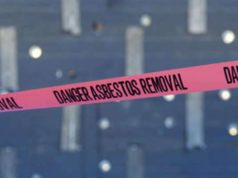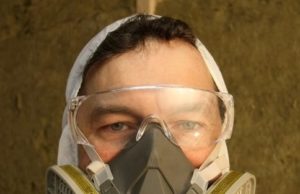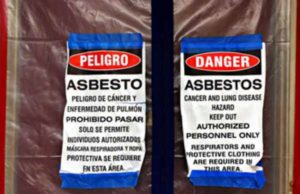
What should be done about asbestos in my home?
You will be surprised to hear that generally you should do nothing about asbestos in your home. Generally, most applications of asbestos materials in the home are sealed in the walls or other indurate material. As long as this material is intact, there is no danger to you. This danger factor changes depending on the application. If the secured application of asbestos breaks down, it will release harmful asbestos fibers. There are also some typical applications of asbestos materials that are an immediate danger. Generally speaking, continuous or heavy exposure to asbestos materials will exacerbate risk factors for lung cancer and long term exposure will lead to asbestos related illness.
It is most important to note that the worst exposure to asbestos fibers will occur during improper abatement by homeowners. Follow this guide to ensure you are safe and prevent secondary contamination or the air in your home or other materials. Most importantly, you are advised for most projects involving a heavy amount of asbestos to include an inspection by an asbestos inspector licensed in the state. You may even need to consider having a professional perform the asbestos abatement.
Places where you will find dangerous asbestos
Insulation is the biggest culprit of asbestos in the home. Most insulation applications are friable, which means that can be broken with minimal force and when this happens, tiny fibers are released. These fibers cannot be seen by the human eye. Asbestos by nature is comprised of fibers. All fibers are comprised of the previously described smaller fibers. Due to their size and weight, asbestos fibers are made easily airborne and inhaled. Asbestos fibers do not break down and remain in the body for decades, damaging the lungs.
You will find friable materials as insulation on pipes, certain types of plaster ceilings and wool-like insulation. These three materials generally need to be removed according to proper asbestos abatement procedure. These are also the three materials that are difficult to remove properly.
Dangers of poor abatement
Removing friable asbestos dry is a mistake. Wetting asbestos fibers prevents their release. The waterlogged fibers do not become airborne and make the subsequent cleanup significantly easier. It is also a mistake to not use HEPA filters and vacuums. These extra-fine filters are necessary to prevent tiny particles from being released and cause secondary contamination.
Plastic sheeting is used in asbestos abatement for good reason. You need to create a controlled environment for asbestos abatement. Professional abatement will use the sheeting in conjunction with an air filter that cycles air through the enclosure while removing fibers that are inevitably disturbed and released. Federal law regarding asbestos abatement mandates the use of these enclosures and that the HEPA filter cycling the air do so completely four times in an hour. This should give you an understanding of the need for proper filtration during asbestos abatement.
Protective clothing and good hygiene must be performed to protect workers from sickening themselves. Federal guidelines mandate a specialized decontamination shower to prevent asbestos fibers from escaping on clothing and equipment worn at the asbestos abatement location. This will not be feasible in your home but should give you an idea that you should be ready to dispose of the tools, clothing and protective material used in the abatement. Some states will mandate that this equipment be disposed of sealed in the same banner as the friable asbestos.
Should I remove asbestos from my home?
There is no law that explicitly states you must remove asbestos from your home. You are bound by laws that provide for the safe disposal of asbestos containing materials and other statutes that provide penalties for irresponsible abatement. The fact is, most asbestos in the home is not dangerous until there is renovation or demolition taking place.
Self-removal of asbestos containing materials will potentially cause more harm than necessary as since breaching indurate material will cause the mass release of harmful fibers. Asbestos abatement procedure minimizes this risk by mandating adequate protection, filters to trap loose particles and techniques such as wetting friable asbestos to prevent fibers from becoming airborne.
What else can I do about asbestos in my home?
The typical homeowner does have more affordable options to safeguard their home. You can seal asbestos fibers to prevent their escape. This is cheaper than removing all the materials and replacing it with safer alternatives. This is called encapsulation and can be performed by a licensed asbestos contractor.
Encapsulation is a viable alternative for surfaces such as plaster ceilings that inevitably break down and leach fibers. As long as the bond remains intact, no fibers will pass through the encapsulation. Surfaces, such as round pipes, that otherwise cannot have the bond applied can undergo enclosure. Enclosure surrounds the friable material with an indurate material, typically concrete, effectively sealing it and preventing the fibers from escaping. Like the encapsulation, as long as the barrier remains intact, there is no danger to you or your family.
Encapsulation eliminates a number of issues, not the least of which is the hassle of removing and safely disposing of asbestos materials. Homeowners cannot dispose of asbestos as typical waste and would have to arrange with a contractor or disposal site to remove the asbestos and comply with state and federal laws. These two procedures, which must be performed by a licensed contractor, can be done for cheaper and is a useful solution to what should be done about asbestos in your home.
Importance of licensing
You must use a licensed contractor only. The license must specifically cover asbestos abatement. All states are mandated to have criteria for contractors performing asbestos abatement. This will include safety training and proven knowledge of performing asbestos abatement procedure.




























